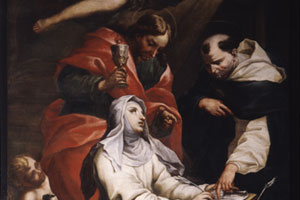The Basilica of San Domenico
The Dominicans in Siena
The order began in the early thirteenth century in Languedoc (France), founded by the Spanish canon Dominic de Guzmán for the purpose of fighting the spread of the Cathar heresy. Dominic and his companions chose to fight the heretical doctrines both by preaching and by the example of severe personal asceticism, living in poverty and begging for their food. Since, in order to refute the heterodox doctrines, it was necessary for the preachers, besides being exemplarily poor, to have also a solid cultural background, Dominican convents became important centers of theological and Biblical studies, and some of the most important medieval theologians, such as Thomas Aquinas and Albert the Great, belonged to the order.
The first friars arrived in Siena with the founder Saint Dominic around 1215-16, when he went to Rome to see Pope Honorius III for approval of the Rule of the Order of Preachers, which was officially decreed on 22 December 1216. At first, the group of friars were given hospitality on the south side of the city; then, in 1225, the Sienese gentleman Fortebraccio Malavolti gave them the Camporegio hill so they could build a church and their convent there.
The settlement of Dominicans in the city of Siena was due mainly to the presence of the Studium (which became the University) and to the fact that the Order had set itself the task of combating heresy and pursuing the . . .



